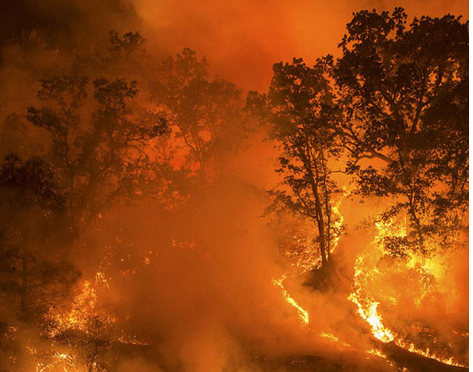
Increase in deadly wildfires in Pacific Northwest directly linked to emissions from Big Oil
Although we are only in May, it has already been a brutal fire season in the Pacific Northwest of Canada and the USA. In Canada, millions have already endured record-breaking temperatures in excess of 90F (32 degrees) this month.

C: World Forestry Center
Although we are only in May, it has already been a brutal fire season in the Pacific Northwest of Canada and the USA.
In Canada, millions have already endured record-breaking temperatures in excess of 90F (32 degrees) this month.
In the west of the country, thousands have already been evacuated and over a million acres have already burned. In Alberta alone, there have already been over 500 fires this year destroying 945,000 hectares, with 67 still active, with 13 serious enough to be “of note.” In total, some 2 million hectares across Canada have burnt.
We've now eclipsed TWO MILLION hectares of wildland burned across Canada 🔥🇨🇦
Both Alberta and Saskatchewan quickly approaching (or surpassing) a million a piece – and this by May long weekend.
Quickly becoming one of the worst fire seasons on record. #Abfire #ABWildfire… pic.twitter.com/4zRe2htNCq
— Kyle Brittain (@BadWeatherKyle) May 21, 2023
Although some rain has been falling, it is likely to be a temporary reprieve from the searing heat over the next few months. Moreover, the wildfires are not just confined to the West, with wildfires raging in Nova Scotia, and thousands forced to leave their homes already.
And now a new scientific report, published in Environmental Research Letters, has tried to calculate how much of this fire activity could be attributed to fossil fuel companies. And they found a direct and measurable link.
Crucial to this understanding is the issue of VPD – or vapor pressure deficit — which is a measure of the atmosphere’s drying power that is significantly influenced by human-caused climate change.
They concluded that based on their climate model data, “we find that emissions traced to 88 major fossil fuel producers contributed 48 percent of the long-term rise in VPD between 1901 and 2021.”
The increase in VPD in this region “is linked to both increased fire activity and the region’s current and prolonged megadrought.”
Therefore the scientists concluded that 37 percent of the total burned forest area in Western Canada and the United States between 1986-2021 can be traced back to these large fossil fuel producers and cement manufacturers.
As an increasing number of lawsuits are launched to hold Big Oil accountable, proving beyond reasonable doubt a direct correlation between emissions and deadly impact is going to be important. As the scientists note: “As loss and damage from these hazards mounts, this research can inform public and legal dialogues regarding the responsibility carbon producers bear for addressing past, present, and future climate risks associated with fires and drought in the western US and southwestern Canada.”
Carly Phillips, co-author on the study and a researcher at the Science Hub for Climate Litigation at the Union of Concerned Scientists, told CBC: “What we found is that the emissions from these companies have dramatically increased wildfire activity.”
This paper adds to the growing evidence of just how much Big Oil is responsible for and should pay for the climate crisis.
Meanwhile, another academic paper, published last month, argued that “that fossil fuel producers contributed to climate harm through their operational and product emissions, have a documented history of climate denial and of discourse and practices of delay, disinformed the public and their shareholders on climate science and corporate risks, are complicit in slowing down or defeating climate legislation, and must be held accountable for climate harm by paying reparations.
They argued that, at a conservative estimate, the largest twenty-one companies analyzed would disburse a staggering USD 5.4 trillion over the period from 2025 to 2050. ExxonMobil, Saudi Aramco, and Shell — the companies most often accused of delaying action on climate change — would have the first, third, and fourth highest reparations.
This would equate to USD 200 billion in yearly climate reparations. It’s time for Big Oil to pay for the chaos it has caused. And continues to cause on a daily basis.
